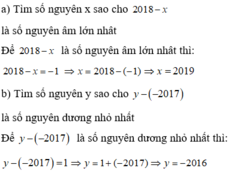Tìm số nguyên x,y ;sao cho:(x-1)(3-y)=2
Hãy nhập câu hỏi của bạn vào đây, nếu là tài khoản VIP, bạn sẽ được ưu tiên trả lời.


a: x+2020 là số nguyên âm lớn nhất
=>x+2020=-1
=>x=-2021
b: y-(-100) là số nguyên dương nhỏ nhất
=>y+100=1
=>y=-99

\(6,\)
\(a,x+2017=-1\)
\(\Rightarrow x=-2018\)
Vậy: \(x=-2018\)
\(b,y-\left(-100\right)=1\)
\(\Rightarrow y+100=1\)
\(\Rightarrow y=-99\)
Vậy: \(y=-99\)

Bài 1:
Để E nguyên thì \(x+5⋮x-2\)
\(\Leftrightarrow x-2\in\left\{1;-1;7;-7\right\}\)
hay \(x\in\left\{3;1;9;-5\right\}\)

a) Ta có: (x-3)(y+2)=5
nên (x-3) và (y+2) là ước của 5
\(\Leftrightarrow x-3;y+2\in\left\{1;-5;-1;5\right\}\)
Trường hợp 1:
\(\left\{{}\begin{matrix}x-3=1\\y+2=5\end{matrix}\right.\Leftrightarrow\left\{{}\begin{matrix}x=4\\y=3\end{matrix}\right.\)
Trường hợp 2:
\(\left\{{}\begin{matrix}x-3=5\\y+2=1\end{matrix}\right.\Leftrightarrow\left\{{}\begin{matrix}x=8\\y=-1\end{matrix}\right.\)
Trường hợp 3:
\(\left\{{}\begin{matrix}x-3=-1\\y+2=-5\end{matrix}\right.\Leftrightarrow\left\{{}\begin{matrix}x=2\\y=-7\end{matrix}\right.\)
Trường hợp 4:
\(\left\{{}\begin{matrix}x-3=-5\\y+2=-1\end{matrix}\right.\Leftrightarrow\left\{{}\begin{matrix}x=-2\\y=-3\end{matrix}\right.\)
Vậy: \(\left(x,y\right)\in\left\{\left(4;3\right);\left(8;-1\right);\left(2;-7\right);\left(-2;-3\right)\right\}\)
b) Ta có: (x-2)(y+1)=5
nên x-2 và y+1 là các ước của 5
\(\Leftrightarrow x-2;y+1\in\left\{1;-1;5;-5\right\}\)
Trường hợp 1:
\(\left\{{}\begin{matrix}x-2=1\\y+1=5\end{matrix}\right.\Leftrightarrow\left\{{}\begin{matrix}x=3\\y=4\end{matrix}\right.\)
Trường hợp 2:
\(\left\{{}\begin{matrix}x-2=5\\y+1=1\end{matrix}\right.\Leftrightarrow\left\{{}\begin{matrix}x=7\\y=0\end{matrix}\right.\)
Trường hợp 3:
\(\left\{{}\begin{matrix}x-2=-1\\y+1=-5\end{matrix}\right.\Leftrightarrow\left\{{}\begin{matrix}x=1\\y=-6\end{matrix}\right.\)
Trường hợp 4:
\(\left\{{}\begin{matrix}x-2=-5\\y+1=-1\end{matrix}\right.\Leftrightarrow\left\{{}\begin{matrix}x=-3\\y=-2\end{matrix}\right.\)
Vậy: \(\left(x,y\right)\in\left\{\left(3;4\right);\left(7;0\right);\left(1;-6\right);\left(-3;-2\right)\right\}\)

\(1,\)
\(\left(x+2\right)^2\ge0;\left(y-4\right)^2\ge0;\left(2y-4\right)^2\ge0\\ \Leftrightarrow\left(x+2\right)^2+\left(y-4\right)^2+\left(2y-4\right)^2\ge0\)
Dấu \("="\Leftrightarrow\left\{{}\begin{matrix}x=-2\\y=4\\y=2\end{matrix}\right.\left(vô.lí\right)\)
Do đó PT vô nghiệm
\(2,\Leftrightarrow x^2-2x-3=0\Leftrightarrow x^2+x-3x-3=0\\ \Leftrightarrow\left(x+1\right)\left(x-3\right)=0\Leftrightarrow\left[{}\begin{matrix}x=-1\\x=3\end{matrix}\right.\)

\(B=\frac{1}{x-y}:\frac{x+2}{2\left(x-y\right)}=\frac{1}{x-y}.\frac{2\left(x-y\right)}{x+2}=\frac{2}{x+2}\)
Để B là số nguyên
=> \(\frac{2}{x+2}\)là số nguyên
=> \(2⋮x+2\)
=> \(x+2\inƯ\left(2\right)\)
=> \(x+2\in\left\{1;-1;2;-2\right\}\)
=> \(x\in\left\{-1;-3;0;-4\right\}\)
Vậy các cặp (x ;y) thỏa mãn là (-1 ; y) ; (-3 ; y) ; (0 ; y) ; (-4 ; y) với mọi y nguyên

4:
(x+1)(y-2)=5
=>\(\left(x+1;y-2\right)\in\left\{\left(1;5\right);\left(5;1\right);\left(-1;-5\right);\left(-5;-1\right)\right\}\)
=>\(\left(x,y\right)\in\left\{\left(0;7\right);\left(4;3\right);\left(-2;-3\right);\left(-6;1\right)\right\}\)
